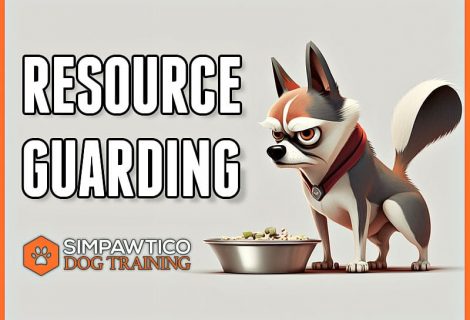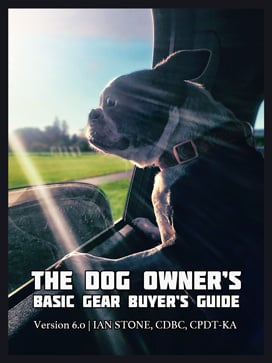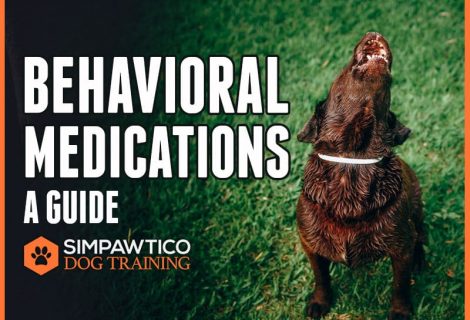How and Why You Might Want to do Crate Training with Your Dog
Crate training is one of the most requested posts you’ve asked me to make. It’s a super useful thing to teach your dog, so here we go! I want to start this off for all the “Crater-Haters.” Every time the subject of crates comes up, many folks pipe up about how cruel and inhumane it is. Guys, you’re coming at it totally wrong. You misunderstand how a crate is used. And you’re talking about what YOU like, not what a dog likes. If you think of it as a cage, then that’s probably how you’re going to treat it, and that’s not how it’s used.
DOGS ARE DENNING ANIMALS
We humans have this whole thing with space and freedom. We like open floor plans and property with acreage. But dogs are denning animals. Ultimately, they like it dark and close. And please understand that whether you use a crate or not, your dog is probably denning up one way or another. This is why dogs:
- Go under end tables and coffee tables
- Why they sleep under covers
- Why they hang out under your desk
- Hide below the printer stand when the neighbor fires up his goddamn leaf blower for the third time this week!
But I digress…
- For other dogs, this is why they like bolster beds
- Nestle into the cushions
- Sit under chairs
- Stretch out behind the couch
I mean, sure, dogs love to lay in the sunshine and run in the fields too, but at the end of the day they’ll end up denning up in whatever fashion they’re comfortable with. Even the most socialized, confident dog will stay somewhere, whether between their owners on the couch or lounging on their dog bed. When we leave our dogs in the kitchen during the day, in a utility room, or in a guest room, we create a den for them. A crate is a safe and protected den for a dog to be in while we cannot supervise them. Of course, some dogs don’t need crates and have never used one, but don’t mistake that for the norm. Those are the outliers. The vast majority of puppies and newly adopted dogs will and do benefit from crate training and intelligent use of a crate.
IT’S NOT FOR TIME-OUTS
One thing along those lines I want to make crystal clear right off the bat is that we never use it as a punishment. It is not for time-outs. Don’t ever put them up when you’re mad at them. This only teaches them to fear and loathe time in the crate, and you’ll create many problems for yourself down the road. A crate, for sure, isn’t necessary for every dog. So, let’s start by discussing some of the pros and cons to help you decide if it’s right for you.
RIGHT OR NOT?
Crates are great for raising a puppy or for helping a new adult dog settle in. While they’re learning the ropes around your house, a crate can help you control destructive behaviors. If nothing else, blocking access to tempting things like your shoes and underwear may be worth the effort.
Best Tool for Housetraining
Crates are necessary for quick, effective, errorless housetraining for a young puppy. But even adult adoptees, even if supposedly potty trained, should still go through the full housetraining regimen. A crate is rarely necessary for mature dogs that are through the potty training process. Many can be home alone or out during the night. The exception is when there’s a specific behavior problem you’re trying to address. Then, a crate may be a helpful component of your treatment plan. Make sure you involve a consultant for these cases.
Environmental Management
Crates also help keep your dog out of trouble without eroding their motivation. We want dogs to want to engage with us with energy, and we don’t want to kill that by always having to deal with mischief. A crate is a great way to manage them when we can’t watch them and get them primed for working with us. A little isolation every day increases motivation to work together for more independent dogs. You can crate these dogs for a couple of hours and then take them out to work together. Even for dogs that don’t need a crate, being crate trained is a good character trait for a dog to possess, as they may be called upon to go into a crate at times. For example, if they’re staying somewhere while you’re out of town, at the vet’s, or even at the groomer, they may need to spend time in a crate. A crate is also the safest option when traveling. A crate can be a reliable and familiar place in the car for your dog. And busy dogs can’t interfere with you while you’re driving.
Compartmentalize Energy & Space
At home, it’s important to have areas of inclusion AND areas of confinement or isolation. We need to be able to control our dogs’ stimulation and compartmentalize it to the places we want. It’s irresponsible to leave that up to chance. We don’t want them jazzed up in the family room at night, and we don’t want them wasted out in the yard when we’re trying to interact with them. Using a crate as part of your practice would help. In any case, a crate shouldn’t be used for extended periods. Crates do not provide any outlet for pent-up energy. If your dog is spending time in a crate, you’ve got to make sure you’re countering that confinement with constructive use of physical exercise and mental stimulation.
A crate can be an efficient management tool, but don’t make the mistake of making it your babysitter.
Think of the crate as a crib or a playpen. We move through stages with babies—cribs, toys, diaper champs, and highchairs—so we must be willing to work through similar stages with our dogs. Ostensibly your dog should grow out of the need for it with guidance and support.
TYPES of CRATES
There are several types of crates out there, so here’s a basic rundown of the main categories:
Plastic Flight Crates
- This is kind of the original standard for crates
- Plastic crates are great for a dog’s first crate
- Plastic is easier to clean up when there are messes. And for big messes, you can disassemble the crate to really get in there
- Plastic crates are generally warmer and drier
- It’s very easy to throw a blanket on it to darken it even more, and this can be very soothing for many dogs
- Plastic crates are usually better for cars; some even have systems to strap them down
- Some have top-loading options for smaller dogs
- Plastic Crates are the only option for flying if your dog is not allowed in the cabin. Most plastic crates are compliant with airline safety standards.
- Plastic crates have lots of affordable options
Wire Crates
- Probably the second most common and useful kind of crate
- They easily fold up for storage or transport
- They offer more vision and more circulation
- Wire crates are suitable for use in a car
- They can get heavy as they get bigger
- You also cannot take them on planes
- Many affordable options
Soft-Sided Crates
- Also, fold up, but they’re made of lighter materials like nylon, vinyl, and aluminum
- Best for travel and convenient setup in hotels or campgrounds
- Not recommended for the crate training process or for a dog with distress or anxiety. These are best for dogs who’ve been trained and are comfortable in a crate
- Affordable, but on the higher end
Fashion Crates
- They are made of finer-grade materials and are made to look like furniture. Some are even custom integrated into existing furniture
- Also best for a dog that’s already accustomed to a crate
- Great for inclusion time
- As you might imagine, Fashion Crates tend to get spendy
Heavy Duty Crates
- Are best for extended transport; they’re used mainly by owners that travel with their dogs regularly, such as those that travel to competitions or trials.
- These are the safest option in the car; they’re built to withstand a full-on car crash
- Heavy Duty crates are amongst the most expensive of all the options
X-Pens
- Also a great addition to your arsenal. They’re a fabulous way-station for your integration routine
- Awesome for puppies and small breeds; it’s a great inclusion space when you transition from a crate
- Moveable and portable, these fold up as a wire crate does
- Not for larger dogs or for highly energetic dogs
- Dogs are always supervised in these; they can learn to get out.
- We typically train this, too; don’t just toss a dog into one and hope for the best
Many puppy experts recommend that you start with BOTH a plastic crate and a wire crate, which will be used at different times. One is for inclusion when the dog is crated but is still in proximity to the family, and one we call a “quiet” crate, which is covered for quiet, alone time. If you can only afford one, then a plastic crate may be the better choice initially. A wire crate may be fine if you’re adopting an older crate trained dog. Once you’re through some of those tougher, early phases, you should be able to progress into Soft-Sided, Fashion, or Heavy Duty if you desire.
SIZING
The baseline is that your dog needs to be able to stand up, turn around, and lie down comfortably in the crate. This is an easy prospect if you’re adopting an older dog that’s pretty much done growing, but for puppies, that can be a little more difficult. Wire crates usually come with a moveable divider. So you can effectively start the crate small and then enlarge it as the puppy grows. This way you only have to buy one wire crate. For your plastic crate, you’ll have to get one big enough to last a little while. Ostensibly, once your puppy’s potty trained, you may not need your plastic crate. We won’t cover Potty training in this video as it’s way outside the scope.
TRAINING
If your dog has had a previous bad experience with a crate or is suffering from Isolation Distress or Separation Anxiety, you will need to seek help from a trainer or behavioral consultant. Don’t try to force the issue or you’ll make it worse. See our video article on Separation Anxiety for more info.
For the rest of the doggos out there, though, it’s usually a pretty straightforward process. We want our dogs to view the crate as a safe place. It should be pleasant and inviting. So, we need to habituate them to it. A neutral response is sufficient, but a good Conditioned Emotional Response (CER) is even better. As with all training, there’s a timing issue. Monitor and control their energy, and don’t try to work on crate training during peak arousal times. Work with them, spend time with them, and wear them out first.
Your first-line strategy is praise, of course. As we’ve repeatedly said on this channel, your voice is your #1 training tool. Consider using a consistent phrase as a cue to go in. Pairing a word or phrase will help directionalize their attention toward where it needs to be. Tie the door back initially, so it doesn’t scare the dog. Doors can swing around randomly and clink and clang on the crate, potentially frightening sensitive dogs and setting your work back. On plastic crates, you can also remove the door entirely.
TRAINING GAME #1: Bait & Restrain
We have a Power Tip post for this game. But in a nutshell, it looks like this:
- Let your dog watch you throw food into their crate, and let them toddle in to get it
- After a few reps, gently restrain them for a moment while you throw the food to increase their drive. Restraint builds drive, and a little positive frustration will make them really want in
- Start using your consistent phrase before throwing the food in
- After a few more reps, start “pre-baiting” the crate. Toss food in with your other hand, so they don’t see it. This way, you use your phrase, and they go inside and discover goodies already there.
- Build duration inside by closing the gate while they eat and opening it when they’re done. Extend this time by feeding through the holes.
- Reduce food and create a procedure just like any other training scenario.
Make sure to check out the post for this to see it done and read a full breakdown.
TRAINING GAME #2: The Bait Locker
We have a POWER TIP post for this one too! But briefly, it works like this:
- Fill a hollow chew toy with food.
- Put the chew toy in the back of the crate and then shut the door.
- When your dog is ASKING to go into the crate to get their toy, open the door and let them in.
- Shut the crate door while they’re eating, and open it when they’re done.
- Build duration as before.
Work-to-Eat Toys
In our Kong video article, we’ve also discussed some other crate training methods. Give that one a watch for some ideas to get you going. Remember that a Kong toy is not the only kind of toy feeder. Other options work just as well:
- PetSafe Squirrel Dude
- PetSafe Barnacle
- OurPets Atomic Ball
- StarMark Chewball
- Westpaw Quizl
- Buster Cubes
- Goodie Ship
- Hollow Butcher Bones
Honestly, though, I think the best are still Kongs, Squirrel Dudes, and Buster Cubes. Frozen marrow bones, kneecaps, and pig’s ears also work great.
Manage Arousal and Energy
No matter what method you use, it’s best to control your dog’s stimulation level in expectation of the work with the crate. Manage their energy. Introduce the crate when your dog is tired. An aroused state makes it harder to settle down and learn to enjoy the crate.
Crate Flow
Keep a baggie or bowl of treats on the crate, so it’s relatively easy to pre-bait the crate. Also, a chew toy or other items will be needed and should be handy. Don’t work on crate training with your dog unless you have food rewards and toy rewards, READY. Set this up and make it convenient for you, OR YOU PROBABLY WON’T DO IT.
Routines are awesome but try not to make your initial training follow a predictable pattern. You want to destabilize the patterns of coming and going to short-circuit expectations. This will preserve the integrity of whatever training you do with the crate. Don’t let your dog make a habit of demanding to be let out.
If your dog is barking for you to open the door in those early phases, here’s how you fix it: EAR PLUGS.
Note: demand barking is covered in Simpawtico’s eBook, “Barking Decoded.”
Take the Time
Crate training is labor intensive but reduces the possibility of problems later on. Be patient. Practice until your dog enters their crate willingly. Depending on the dog, this could take several days. Don’t rush it; the dog will tell you how fast to go. Practice until your dog is all right in the crate for about 30 minutes before leaving the house. This will minimize stress when you do leave. Make the first leaving a short one: maybe an hour or so.
Be Neutral at the End
Finally, if you make a big production out of letting your dog out, you potentially create a couple of situations:
- If you condition your dog to be super aroused when you let them out; these dogs will launch out of the crate at you like a torpedo
- The dog starts to feel like being out of the crate is better than being in the crate; these dogs will become more reluctant to go in
Be enthusiastic about getting into the crate, but be just kind of neutral about letting your dog out.
USING THE CRATE
Line your crate with a soft towel or mat
If your dog is chewing up beds, a towel may be a better option until chew toy training is under wraps. We’ll put some good liner recommendations in the notes below.
Timing for Potty Training
Puppy training should never involve crating longer than your puppy can reasonably be expected to hold their bladder. The general rule of thumb is one hour per month plus one, so at
- 2 months ≈ 2-3 hours
- 3 months ≈ 3-4 hours
- 4 months ≈ 4-5 hours
- …and so on
Until potty training is sewn up, puppy owners should consider coming home on a lunch break or having someone let the pup out. Adults don’t need as many potty breaks, although, as we mentioned, all newly adopted adult dogs should still undergo a full potty training regimen, including crate confinement.
Don’t leave food in the crate
There is no situation where your dog should require food in the crate. As we’ve mentioned many times before, dogs should not be free-fed; they should be on routine+timed feedings. And, your dog should never be crated so long that they require food available in the crate anyway. The only time food is available in the crate is when we’re toy-feeding them to habituate them to be inside it. This is a temporary situation during our training progression.
Water is a little different
If your dog is only in the crate for a couple of hours at a time, water is not necessary, although if you’re a working stiff and your dog spends several hours a day in there, you may want to consider making water available. Do not use a bowl…get a water bottle. This is a lot less messy and more compact without taking up interior real estate. I’ll link to some options in the description.
Consider Making a Bigger Den
However, for those dogs that spend long hours alone, you may want to consider making a bigger den apartment. You can give adult dogs more room to hang out, and the puppy version includes a toilet that will expedite your potty training. These were recommended and designed by world-class behaviorists and trainers. Check out our video article, all about how to do it!
Deuces
We mentioned our recommendation that you have two crates initially: an inclusion crate in a room where you spend the most time and a quiet crate. If you’ve got a second quiet crate, put that in a…well…quiet place. This is another method for managing energy. There will be times when your dog needs to settle down for a nap in a dark, quiet place, and there are times when your dog can hang out with the family but still needs to learn how to occupy themselves. Since they’re supervised, this is a good time for a chew toy, and later on, this will be a good opportunity to use that X-Pen.
Crate Flow2
However you set things up, one crate or two, set up the flow so that you can move your dog around easily. Don’t put their crate in the upstairs back bedroom. Especially if you’re potty training, you need to be able to get them outside quickly and easily!
Set up your house to make it easy for you, or it won’t get done.
GOOD LUCK!
All right, guys, this should cover most of your crate training conundrums. If you run into any bigger snags, buddy up with a local trainer to help you iron out the kinks. Now question for you: what are some ways your dog dens up, whether in a crate or otherwise? Also, what other things would you like us to discuss? Let us hear from you in the comments below! Good luck with your crate training. As always, keep learning, keep practicing, and we’ll see you next time. Thanks for looking!
RESOURCES
The links below are affiliate links. These won’t cost you anything, but the commissions we may earn through them help offset the cost of dog treats. Thanks for your support!
CRATE LINERS & PADS
Maxx Dog Bed: This is just like the Kong mat/pad without Kong pricing.
Simmons Beautyrest Orthopedic Memory Foam: Actually pretty affordable for a Simmons!
4” Orthopedic Pad w/washable cover: This one is spendy but WOW, I’d even sleep on this.
WATER BOTTLES
Lixit top-fill bottles:
The reviews are spotty on this brand, but one reviewer pointed out: “This company uses USA Adults with Disabilities to assemble this product, there is a chance that some are assembled incorrectly (not machine assembled)….” Evidently, any leaking out of the package is a super easy fix. I kind of want to support this company.
WORK-TO-EAT TOYS for TRAINING










We’re a group of volunteers and starting a new scheme in our community. Your web site offered us with valuable information to work on. You’ve done an impressive job and our whole community will be grateful to you.